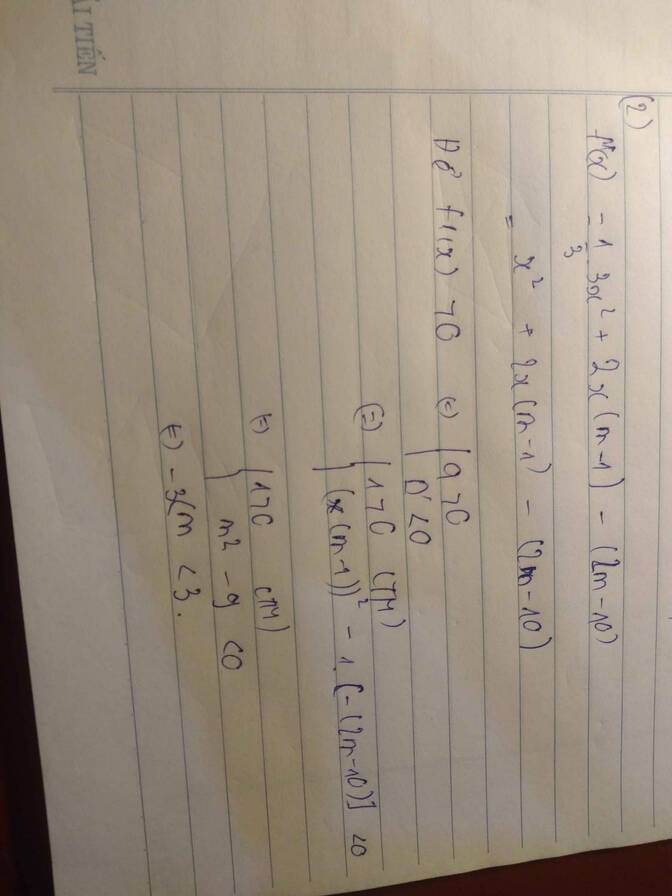Hãy nhập câu hỏi của bạn vào đây, nếu là tài khoản VIP, bạn sẽ được ưu tiên trả lời.

\(f'\left(x\right)=4x^3-4x=0\Rightarrow\left[{}\begin{matrix}x=0\\x=1\\x=-1\end{matrix}\right.\)
Để \(g\left(x\right)_{min}>0\Rightarrow f\left(x\right)=0\) vô nghiệm trên đoạn đã cho
\(\Rightarrow\left[{}\begin{matrix}-m< -2\\-m>7\end{matrix}\right.\) \(\Rightarrow\left[{}\begin{matrix}m>2\\m< -7\end{matrix}\right.\)
\(g\left(0\right)=\left|m-1\right|\) ; \(g\left(1\right)=\left|m-2\right|\) ; \(g\left(2\right)=\left|m+7\right|\)
Khi đó \(g\left(x\right)_{min}=min\left\{g\left(0\right);g\left(1\right);g\left(2\right)\right\}=min\left\{\left|m-2\right|;\left|m+7\right|\right\}\)
TH1: \(g\left(x\right)_{min}=g\left(0\right)\Leftrightarrow\left\{{}\begin{matrix}\left|m-2\right|\le\left|m+7\right|\\\left|m-2\right|=2020\\\end{matrix}\right.\) \(\Leftrightarrow\left\{{}\begin{matrix}m\ge\dfrac{5}{2}\\\left|m-2\right|=2020\end{matrix}\right.\) \(\Rightarrow m=2022\)
TH2: \(g\left(x\right)_{min}=g\left(2\right)\Leftrightarrow\left\{{}\begin{matrix}\left|m+7\right|\le\left|m-2\right|\\\left|m+7\right|=2020\end{matrix}\right.\)
\(\Rightarrow\left\{{}\begin{matrix}m\le\dfrac{5}{2}\\\left|m+7\right|=2020\end{matrix}\right.\) \(\Rightarrow m=-2027\)

\(\lim\limits_{x\rightarrow2^+}f\left(x\right)=\lim\limits_{x\rightarrow2^+}\sqrt{2x-4}+3\)
\(=\sqrt{2\cdot2-4}+3=3\)
\(f\left(2\right)=\sqrt{2\cdot2-4}+3=0+3=3\)
\(\lim\limits_{x\rightarrow2^-}f\left(x\right)=\lim\limits_{x\rightarrow2^-}\dfrac{x+2}{x^2-2mx+m^2+2}\)
\(=\dfrac{2+2}{2^2-2m\cdot2+m^2+2}=\dfrac{4}{m^2-4m+6}\)
Để hàm số f(x) liên tục trên R thì f(x) liên tục tại x=2
=>\(\dfrac{4}{m^2-4m+6}=3\)
=>\(4=3\left(m^2-4m+6\right)\)
=>\(3m^2-12m+18-4=0\)
=>\(3m^2-12m+14=0\)
\(\Leftrightarrow3m^2-12m+12+2=0\)
=>\(3\left(m-2\right)^2+2=0\)(vô lý)
=>\(m\in\varnothing\)

Ta có:
lim x → 0 − f x = lim x → 0 − x + m = m ; lim x → 0 + f x = lim x → 0 + x 2 + 1 = 1
Hàm số có giới hạn tại x = 0 ⇔ lim x → 0 − f x = lim x → 0 + f x ⇔ m = 1
Chọn đáp án D

Ta có:
lim x → − 1 − h x = lim x → − 1 − x 3 + 1 x + 1 = lim x → − 1 − x 2 − x + 1 = 3 lim x → − 1 + h x = lim x → − 1 + m x 2 − x + m 2 = m + 1 + m 2
Hàm số có giới hạn tại x= -1 khi và chỉ khi lim x → − 1 − h x = lim x → − 1 + h x
3 = m + 1 + m 2 ⇔ m 2 + m − 2 = 0 ⇔ m = 1 m = − 2
Chọn đáp án C
tìm tổng tất cra các giá trị của tham số thực m để hàm số y=|mx-1|-x^2 có giá trị lớn nhất bằng 10/8





Ta có :
lim x → 1 − f x = lim x → 1 − m − 3 = m − 3 lim x → 1 + f x = lim x → 1 + 1 − 7 x 2 + 2 = − 2
Để tồn tại lim x → 1 f ( x ) khi và chỉ khi:
lim x → 1 − f x = lim x → 1 + f x ⇔ m − 3 = − 2 ⇔ m = 1
Chọn đáp án B